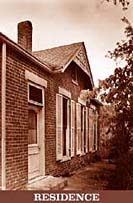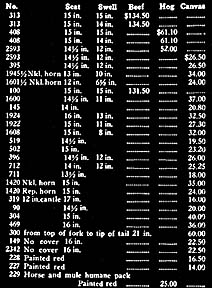Saddle
Trees:

The internal wooden skeletons of
saddles. Saddle makers buy saddle trees from saddle tree
manufacturers and finish the saddles by cutting, fitting,
and sewing tanned leather around the tree.
INTRODUCTION
Although Madison, Indiana was
important hub of the saddle tree industry during the late
19th century (its twelve  shops made over 150,000 trees
in 1879), there were few local saddle makers. The
majority of saddle trees produced in this city were
marketed to saddle makers through flyers, catalogs, and
advertisements in trade publications. shops made over 150,000 trees
in 1879), there were few local saddle makers. The
majority of saddle trees produced in this city were
marketed to saddle makers through flyers, catalogs, and
advertisements in trade publications.
Two generations of the
John Benedict "Ben" Schroeder family made and
sold thousands of saddle trees to saddle makers
throughout the United States, Canada and South America
between 1878 and 1972. The No. 4 Catalog was the
final sales piece used by the Schroeder company, the
culmination of 50 years of marketing Schroeder-made
products.
The catalog has now
been reproduced, and is available for a nominal charge by
contacting Historic Madison. This reproduction catalog
was made directly from an original. In addition, the
1920s-era colored art work of the first six saddle trees
was used to recreate crisp, accurate images. These
valuable resources are part of the Schroeder Collection,
owned by Historic Madison Foundation, Inc., containing
thousands of business and personal records. It is
believed to be the most complete collection of historic
saddle tree industry documents in the nation.
THE NO.
4 CATALOG
The catalog was produced in 1931,
a bad time for the trade. By then, the automobile had
eliminated the horse as the main form of personal
transportation, forcing many saddle tree makers out of
business. Others succumbed to the Great Depression. The No.
4 Catalog demonstrated that the Schroeder Company
remained active, despite the uncertain times. Thirty
models are illustrated, representative of the 250 styles
crafted in the Schroeder plant. Six are shown in color on
the first two pages.
The yellow trees were
hide covered, a costly process of hand stitching  wet rawhide around the wooden
frames for added strength. The stitching on the four
hide-covered trees illustrated is clearly seen. Finished
trees of this type were painted yellow to prevent rot and
insect damage. These tough saddle trees were used in
cowboy saddles because they endured the rigors of roping
and other range work without breaking. wet rawhide around the wooden
frames for added strength. The stitching on the four
hide-covered trees illustrated is clearly seen. Finished
trees of this type were painted yellow to prevent rot and
insect damage. These tough saddle trees were used in
cowboy saddles because they endured the rigors of roping
and other range work without breaking.
The two red trees were
covered with canvas, a cheaper alternative to  animal hide. These trees were
wrapped, mummy-like, in fabric dipped in glue and painted
with red lead as a preservative. Canvas covered trees
were used in saddles that were not subject to the
stresses of cowboy life. animal hide. These trees were
wrapped, mummy-like, in fabric dipped in glue and painted
with red lead as a preservative. Canvas covered trees
were used in saddles that were not subject to the
stresses of cowboy life.
A price list in the
back of the catalog shows the cost of the trees by the,,
dozen. The cheapest model, 319, cost $1.33 each, while
the most expensive model sold for $11.21 per tree. Wooden
saddle trees today start at $125 each. (Many
modern trees are plastic. These cost from $30 to $60 per
tree.

Section
of price list from Catalog #4
Also illustrated are
other products made or marketed by the Schroeder firm,
including pack saddles, pack saddle braces and stirrups.
THE
SCHROEDER FAMILY
John Benedict "Ben"
Schroeder was a German immigrant who realized the
American dream. Born in Prussia in 1848, he came to the
United States during the Civil War in 1864. In 1871 he
put down roots in Madison, Indiana. He learned his trade
in John Schramm's Walnut Street saddle tree shop. In 1878
Ben bought land and built his factory.
Ben married Elizabeth
Backus, in 1882 and converted the factory into a house.
He moved the shop into a wood frame building in the
backyard. Between 1883 and 1897, the couple had eight
children. Additions to the residence were made in 1898
and 1903 to accommodate the growing family. During this
time he also added a steam engine and woodworking
machinery to his expanding factory.
Ben was well know in
the community. He was a founding member of the first
German Building and Aid Association of Madison, formed in
1871 to help "needy and proper persons" buy
land and build houses. He was an active member of the St.
Peter's an organization dedicated to assisting German
Catholics in need. He served as a city councilman from
1904 until his untimely death in 1909.
Elizabeth Schroeder and
her older children managed the business after Ben died.
An offer to buy the company in 1911 by an out-of-town
firm was rejected, as was the proposal to combine all
manufacturers into a saddle tree monopoly.
In 1919, Elizabeth died
and her six surviving children, Leo, John, Joseph,
Charles, Pauline, and Gertrude incorporated the business
in memory of their father. Pauline was married and lived
in Michigan, but her brothers and sister remained at home
and worked in the shop. In 1920 a fire nearly destroyed
the factory and in 1921 John left the firm.
The family survived an
industry-wide downturn during the 1920's and the  economic hardships of the Great
Depression by manufacturing clothespins, stirrups, lawn
furniture and hames to counteract the declining demand
for saddle trees. They used family-owned woodlands to
supply logs for the business and modified the factory to
meet these changing needs. economic hardships of the Great
Depression by manufacturing clothespins, stirrups, lawn
furniture and hames to counteract the declining demand
for saddle trees. They used family-owned woodlands to
supply logs for the business and modified the factory to
meet these changing needs.
During the 1940's,
demand for saddle trees increased, so other product lines
were dropped. In the 1950's, demand slackened and few
saddle trees were made.
Advancing age took its
toll. Leo died in 1956. Gertrude followed in 1962 after a
long illness. Charles passed away in 1965, leaving Joseph
alone to continue the business. An accident on a winter's
day in 1972 brought an end to his life. A chapter in
American history ended as well, when the nation's last
19th century saddle tree factory closed its doors
forever.
|

